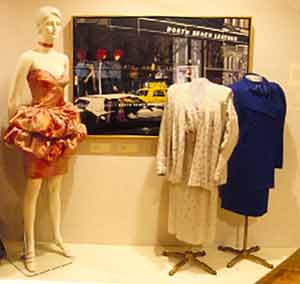1980-1989
In this
period there was unprecedented prosperity for some, but
at the same time a rising tide of troubling social ills
would increasingly challenge the complacency of the affluent.
By the eighties the debate over whether wives and mothers
should work had ended; now the issue was how far up the
professional ladder a woman might rise. As women began to
test the “glass ceiling,” dress shifted to a more
aggressive mode. Shoulder pads, tailoring, strongly colored
patterns and dramatic silhouettes signaled that women intended
to be noticed and taken seriously. During this period dramatic
new forms also began to emerge from new quarters, as designers
of non-European origin emerged to contribute to the language
of fashion. In art, realism merged with surrealism, and
abstraction merged with graffiti to created bold images
that commented on popular culture, poverty, and the new
tragedy of the AIDs epidemic.

|

next decade
back to top
|






